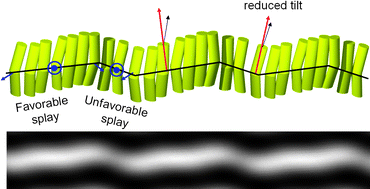2-D Density-modulated structures in asymmetric bent-core liquid crystals
Abstract
Two-dimensional (2-D) density-modulated structures are studied in liquid crystals made of asymmetric bent-core molecules. There are two types of interactions among the molecules proposed, which lead to density modulations. The first type is due to the in-layer interactions and it is specific for bent-core molecules; the bulky cores of the molecules tend to pack such that the orientation of the cores, and thus the local polarization, splay along the layer. The splay leads to undulation of smectic layers, i.e. to 2-D density-modulated structures. The second type of interaction is specific for asymmetric molecules, which can be either bent-core or rod-like in shape. Asymmetric molecules tend to form dimers, which leads to interlayer interactions. Usually the dimer length is slightly less than twice the monomer length; the frustration between the molecular and dimer lengths can be reduced by the formation of in-plane mass density waves. These waves, which are well known in asymmetric rod-like LC systems (called frustrated smectics) are reported for the first time in bent-core liquid crystal systems.


 Please wait while we load your content...
Please wait while we load your content...